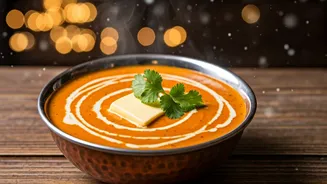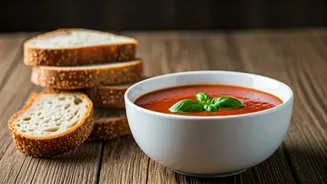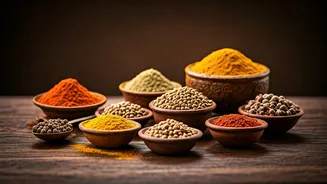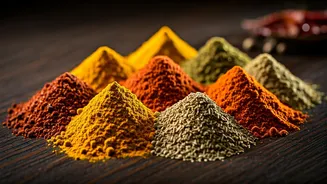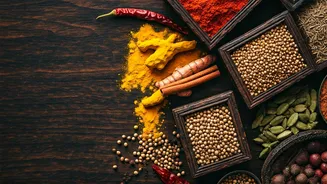Spice Route Unveiled
India's culinary identity is deeply intertwined with its rich history, shaped significantly by trade and cultural exchange. Spices, the heart and soul
of Indian cooking, played a pivotal role, attracting traders from across the globe, especially from the Spice Route. This historical interaction introduced a wealth of ingredients, techniques, and culinary influences, enriching local cuisines and leading to the diverse and complex flavor profiles found today. The strategic location of India along ancient trade routes facilitated the blending of various culinary practices, resulting in a fascinating tapestry of tastes, aromas, and textures. The widespread use of spices like turmeric, cumin, coriander, and cardamom isn't simply about enhancing flavor; they also carry significant health benefits, often incorporated into traditional remedies. This long-standing connection with spices emphasizes the unique position of Indian cuisine in global culinary history, highlighting its ability to embrace and integrate influences while maintaining its distinct identity.
Regional Cooking Styles
Indian cuisine is far from monolithic; instead, it is a mosaic of regional variations, each boasting distinct cooking methods, ingredients, and dishes. In the north, the influence of the Mughals is apparent in the rich, creamy gravies and the extensive use of dairy products. Think of the decadent butter chicken and flavorful biryanis, dishes that reflect centuries of culinary innovation. Heading south, the cuisine transforms, featuring lighter, more refreshing meals with a strong emphasis on rice, lentils, and coconut. Dosa, idli, and sambar are common, offering a different flavor profile altogether. Moving towards the east, the emphasis shifts to the use of mustard oil and fish, particularly in Bengal, where dishes are often delicately spiced and cooked with a focus on fresh ingredients. The western region has its own distinctive character, influenced by its coastal proximity, leading to the use of seafood and coconut milk. Every region has its own way of cooking. These regional variations highlight the incredible diversity of Indian cuisine and how it is intertwined with India's geographical and cultural diversity.
Key Cooking Techniques
Several traditional cooking methods define Indian cuisine, each contributing to its unique flavors and textures. Tandoor cooking, originating from the ancient tandoor oven, imparts a smoky flavor to meats and breads. Marinating is another important process, often used to tenderize and flavor meats and vegetables. Frying, both deep and shallow, is also extensively utilized, enhancing the flavor of various dishes. Steaming is a gentle method that preserves the natural flavors and nutrients of the ingredients. Roasting is another widely used technique, often used for vegetables and spices. Each technique plays a crucial role in creating the authentic taste. The perfect balance of these techniques, coupled with the skillful use of spices, is what truly sets Indian cuisine apart, creating a complex and satisfying culinary experience. The skill with which these techniques are employed showcases the time-honored practices passed down through generations.
Iconic Indian Dishes
Indian cuisine features a vast array of iconic dishes that have garnered global recognition. Butter chicken, a creamy tomato-based dish with tender chicken, is a favorite worldwide. Biryani, a fragrant rice dish with meat or vegetables, is prepared in numerous ways across the country, each region adding its own twist. Dosa, a thin, crispy pancake made from fermented batter, is a popular breakfast staple. Samosas, the crispy fried or baked pastry filled with potatoes and spices, are another well-loved snack. The variety of Indian desserts such as gulab jamun, jalebi and rasgulla, offers an array of sweet tastes. These dishes represent only a small sample of the diverse and fascinating culinary landscape of India. Each dish not only provides an explosion of taste but also tells a story of the cultural traditions of its region.
Food and Culture
Food in India transcends mere sustenance, playing a crucial role in social and cultural traditions. Food is often a central part of festivities, rituals, and celebrations across India. Wedding feasts are a showcase of culinary artistry, while seasonal festivals feature dishes tied to the season and the harvest. The act of sharing food is also deeply ingrained in Indian culture, representing hospitality, community, and bonding. Vegetarianism is widely practiced in India, reflecting religious and philosophical beliefs, with many communities prioritizing plant-based diets. The concept of 'athithi devo bhava' or 'the guest is equivalent to God' signifies the importance of treating guests with warmth, and offering them the best food. This deep-rooted connection between food and culture showcases the importance of meals in Indian society. The emphasis on community and the sharing of food further enhances its cultural relevance.



